Functional Poly(dihalopentadiene)s: Stereoselective Synthesis, Aggregation-Enhanced Emission and Sensitive Detection of Explosives
Abstract
1. Introduction
2. Experimental Section
2.1. Materials and Methods
2.2. Polymerization
2.3. Preparation of Model Compounds
3. Results and Discussion
3.1. Polymer Synthesis
3.2. Structural Characterization
3.3. Solubility and Thermal Stability
3.4. Light Refraction and Chromatic Dispersion
3.5. Aggregation-Enhanced Emission
3.6. Explosive Detection
4. Conclusions
Supplementary Materials
Author Contributions
Funding
Conflicts of Interest
References
- Carraher, C.E. Introduction to Polymer Chemistry; CRC Press: Boca Raton, FL, USA, 2007. [Google Scholar]
- Natta, G.; Danusso, F. Stereoregular Polymers and Stereospecific Polymerizations: The Contributions of Giulio Natta and His School to Polymer Chemistry; Elsevier: Atlanta, GA, USA, 2013. [Google Scholar]
- Ochiai, B.; Ogihara, T.; Mashiko, M.; Endo, T. Synthesis of rare-metal absorbing polymer by three-component polyaddition through combination of chemo-selective nucleophilic and radical additions. J. Am. Chem. Soc. 2009, 131, 1636–1637. [Google Scholar] [CrossRef] [PubMed]
- Espeel, P.; Goethals, F.; Du Prez, F.E. One-pot multistep reactions based on thiolactones: Extending the realm of thiol-ene chemistry in polymer synthesis. J. Am. Chem. Soc. 2011, 133, 1678–1681. [Google Scholar] [CrossRef] [PubMed]
- Blasco, E.; Sims, M.B.; Goldmann, A.S.; Sumerlin, B.S.; Barner-Kowollik, C. 50th anniversary perspective: Polymer functionalization. Macromolecules 2017, 50, 5215–5252. [Google Scholar] [CrossRef]
- Bae, I.; Han, H.; Chang, S. Highly efficient one-pot synthesis of N-sulfonylamidines by Cu-catalyzed three-component coupling of sulfonyl azide, alkyne, and amine. J. Am. Chem. Soc. 2005, 127, 2038–2039. [Google Scholar] [CrossRef] [PubMed]
- Yoo, E.J.; Bae, I.; Cho, S.H.; Han, H.; Chang, S. A facile access to N-sulfonylimidates and their synthetic utility for the transformation to amidines and amides. Org. Lett. 2006, 8, 1347–1350. [Google Scholar] [CrossRef] [PubMed]
- Cho, S.H.; Yoo, E.J.; Bae, L.; Chang, S. Copper-catalyzed hydrative amide synthesis with terminal alkyne, sulfonyl azide, and water. J. Am. Chem. Soc. 2005, 127, 16046–16047. [Google Scholar] [CrossRef] [PubMed]
- Kim, S.H.; Park, S.H.; Choi, J.H.; Chang, S. Sulfonyl and phosphoryl azides: Going further beyond the click realm of alkyl and aryl azides. Chem. Asian J. 2011, 6, 2618–2634. [Google Scholar] [CrossRef] [PubMed]
- Liu, Y.; Qin, A.J.; Tang, B.Z. Polymerizations based on triple-bond building blocks. Prog. Polym. Sci. 2018, 78, 92–138. [Google Scholar] [CrossRef]
- Kakuchi, R. Multicomponent reactions in polymer synthesis. Angew. Chem. Int. Ed. 2014, 53, 46–48. [Google Scholar] [CrossRef] [PubMed]
- Hu, R.R.; Li, W.Z.; Tang, B.Z. Recent advances in alkyne-based multicomponent polymerizations. Macromol. Chem. Phys. 2016, 217, 213–224. [Google Scholar] [CrossRef]
- Long, Z.; Mao, L.C.; Liu, M.Y.; Wan, Q.; Wan, Y.Q.; Zhang, X.Y.; Wei, Y. Marrying multicomponent reactions and aggregation-induced emission (AIE): New directions for fluorescent nanoprobes. Polym. Chem. 2017, 8, 5644–5654. [Google Scholar] [CrossRef]
- Kim, H.; Bang, K.T.; Choi, I.; Lee, J.K.; Choi, T.L. Diversity-oriented polymerization: One-shot synthesis of library of graft and dendronized polymers by Cu-catalyzed multicomponent polymerization. J. Am. Chem. Soc. 2016, 138, 8612–8622. [Google Scholar] [CrossRef] [PubMed]
- Zheng, C.; Deng, H.Q.; Zhao, Z.J.; Qin, A.J.; Hu, R.R.; Tang, B.Z. Multicomponent tandem reactions and polymerizations of alkynes, carbonyl chlorides, and thiols. Macromolecules 2015, 48, 1941–1951. [Google Scholar] [CrossRef]
- Deng, H.Q.; Hu, R.R.; Zhao, E.G.; Chan, C.Y.K.; Lam, J.W.Y.; Tang, B.Z. One-pot three-component tandem polymerization toward functional poly(arylene thiophenylene) with aggregation-enhanced emission characteristics. Macromolecules 2014, 47, 4920–4929. [Google Scholar] [CrossRef]
- Kreye, O.; Toth, T.; Meier, M.A.R. Introducing multicomponent reactions to polymer science: Passerini reactions of renewable monomers. J. Am. Chem. Soc. 2011, 133, 1790–1792. [Google Scholar] [CrossRef] [PubMed]
- Sehlinger, A.; Dannecker, P.K.; Kreye, O.; Meier, M.A.R. Diversely substituted polyamides: Macromolecular design using the Ugi four-component reaction. Macromolecules 2014, 47, 2774–2783. [Google Scholar] [CrossRef]
- Xue, H.D.; Zhao, Y.; Wu, H.B.; Wang, Z.L.; Yang, B.; Wei, Y.; Wang, Z.M.; Tao, L. Multicomponent combinatorial polymerization via the Biginelli reaction. J. Am. Chem. Soc. 2016, 138, 8690–8693. [Google Scholar] [CrossRef] [PubMed]
- Deng, X.X.; Du, F.S.; Li, Z.C. Combination of orthogonal ABB and ABC multicomponent reactions toward efficient divergent synthesis of dendrimers with structural diversity. ACS Macro Lett. 2014, 3, 667–670. [Google Scholar] [CrossRef]
- Leitch, D.C.; Kayser, L.V.; Han, Z.Y.; Siamaki, A.R.; Keyzer, E.N.; Gefen, A.; Arndtsen, B.A. A palladium-catalysed multicomponent coupling approach to conjugated poly(1,3-dipoles) and polyheterocycles. Nat. Commun. 2015, 6, 7411. [Google Scholar] [CrossRef] [PubMed]
- Liu, Y.J.; Roose, J.; Lam, J.W.Y.; Tang, B.Z. Multicomponent polycoupling of internal diynes, aryl diiodides, and boronic acids to functional poly(tetraarylethene)s. Macromolecules 2015, 48, 8098–8107. [Google Scholar] [CrossRef]
- Deng, H.Q.; Zhao, E.G.; Li, H.K.; Lam, J.W.Y.; Tang, B.Z. Multifunctional poly(N-sulfonylamidine)s constructed by Cu-catalyzed three-component polycouplings of diynes, disulfonyl azide, and amino esters. Macromolecules 2015, 48, 3180–3189. [Google Scholar] [CrossRef]
- Lee, I.H.; Kim, H.; Choi, T.L. Cu-catalyzed multicomponent polymerization to synthesize a library of poly(N-sulfonylamidines). J. Am. Chem. Soc. 2013, 135, 3760–3763. [Google Scholar] [CrossRef] [PubMed]
- Zhang, Z.; You, Y.Z.; Wu, D.C.; Hong, C.Y. Syntheses of sequence-controlled polymers via consecutive multicomponent reactions. Macromolecules 2015, 48, 3414–3421. [Google Scholar] [CrossRef]
- Kim, H.; Choi, T.L. Preparation of a library of poly(N-sulfonylimidates) by Cu-catalyzed multicomponent polymerization. ACS Macro Lett. 2014, 3, 791–794. [Google Scholar] [CrossRef]
- Deng, H.Q.; Han, T.; Zhao, E.G.; Kwok, R.T.K.; Lam, J.W.Y.; Tang, B.Z. Multicomponent polymerization: Development of a one-pot synthetic route to functional polymers using diyne, N-sulfonyl azide and water/ethanol as reactants. Polym. Chem. 2016, 7, 5646–5654. [Google Scholar] [CrossRef]
- Deng, H.Q.; Han, T.; Zhao, E.G.; Kwok, R.T.K.; Lam, J.W.Y.; Tang, B.Z. Multicomponent click polymerization: A facile strategy toward fused heterocyclic polymers. Macromolecules 2016, 49, 5475–5483. [Google Scholar] [CrossRef]
- Xu, L.G.; Hu, R.R.; Tang, B.Z. Room temperature multicomponent polymerizations of alkynes, sulfonyl azides, and iminophosphorane toward heteroatom-rich multifunctional poly(phosphorus amidine)s. Macromolecules 2017, 50, 6043–6053. [Google Scholar] [CrossRef]
- Xu, L.G.; Zhou, F.; Liao, M.; Hu, R.R.; Tang, B.Z. Room temperature multicomponent polymerizations of alkynes, sulfonyl azides, and N-protected isatins toward oxindole-containing poly(N-acylsulfonamide)s. Polym. Chem. 2018, 9, 1674–1683. [Google Scholar] [CrossRef]
- Wei, B.; Li, W.Z.; Zhao, Z.J.; Qin, A.J.; Hu, R.R.; Tang, B.Z. Metal-free multicomponent tandem polymerizations of alkynes, amines, and formaldehyde toward structure- and sequence-controlled luminescent polyheterocycles. J. Am. Chem. Soc. 2017, 139, 5075–5084. [Google Scholar] [CrossRef] [PubMed]
- Karpov, A.S.; Muller, T.J.J. Straightforward novel one-pot enaminone and pyrimidine syntheses by coupling-addition-cyclocondensation sequences. Synthesis 2003, 2003, 2815–2826. [Google Scholar] [CrossRef]
- Karpov, A.S.; Muller, T.J.J. New entry to a three-component pyrimidine synthesis by TMS-ynones via Sonogashira coupling. Org. Lett. 2003, 5, 3451–3454. [Google Scholar] [CrossRef] [PubMed]
- Pohlki, F.; Doye, S. The catalytic hydroamination of alkynes. Chem. Soc. Rev. 2003, 32, 104–114. [Google Scholar] [CrossRef] [PubMed]
- Muller, T.E.; Hultzsch, K.C.; Yus, M.; Foubelo, F.; Tada, M. Hydroamination: Direct addition of amines to alkenes and alkynes. Chem. Rev. 2008, 108, 3795–3892. [Google Scholar] [CrossRef] [PubMed]
- Severin, R.; Doye, S. The catalytic hydroamination of alkynes. Chem. Soc. Rev. 2007, 36, 1407–1420. [Google Scholar] [CrossRef] [PubMed]
- Deng, H.Q.; He, Z.K.; Lam, J.W.Y.; Tang, B.Z. Regio- and stereoselective construction of stimuli-responsive macromolecules by a sequential coupling-hydroamination polymerization route. Polym. Chem. 2015, 6, 8297–8305. [Google Scholar] [CrossRef]
- Deng, H.Q.; Hu, R.R.; Leung, A.C.S.; Zhao, E.G.; Lam, J.W.Y.; Tang, B.Z. Construction of regio- and stereoregular poly(enaminone)s by multicomponent tandem polymerizations of diynes, diaroyl chloride and primary amines. Polym. Chem. 2015, 6, 4436–4446. [Google Scholar] [CrossRef]
- Kabalka, G.W.; Wu, Z.Z.; Ju, Y.H. A new reaction of aryl aldehydes with aryl acetylenes in the presence of boron trihalides. Org. Lett. 2002, 4, 1491–1493. [Google Scholar] [CrossRef] [PubMed]
- Kabalka, G.W.; Yao, M.L.; Borella, S.; Wu, Z.Z.; Ju, Y.H.; Quick, T. Boron trihalide mediated alkyne-aldehyde coupling reactions: A mechanistic investigation. J. Org. Chem. 2008, 73, 2668–2673. [Google Scholar] [CrossRef] [PubMed]
- Zhang, Y.; Tseng, N.W.; Deng, H.Q.; Kwok, R.T.K.; Lam, J.W.Y.; Tang, B.Z. BCl3-mediated polycoupling of alkynes and aldehydes: A facile, metal-free multicomponent polymerization route to construct stereoregular functional polymers. Polym. Chem. 2016, 7, 4667–4674. [Google Scholar] [CrossRef]
- Wu, H.Q.; Li, H.K.; Kwok, R.T.K.; Zhao, E.G.; Sun, J.Z.; Qin, A.J.; Tang, B.Z. A recyclable and reusable supported Cu(I) catalyzed azide-alkyne click polymerization. Sci. Rep. 2014, 4, 5107. [Google Scholar] [CrossRef] [PubMed]
- Lansinger, J.M.; Ronald, R.C. Reactions of aromatic aldehydes with boron halides. Synth. Commun. 1979, 9, 341–349. [Google Scholar] [CrossRef]
- Si, J.J.; Xu, P.J.; He, W.; Wang, S.J.; Jing, X.L. Bis-benzoxazine resins with high char yield and toughness modified by hyperbranched poly(resorcinol borate). Compos. Part A Appl. Sci. Manuf. 2012, 43, 2249–2255. [Google Scholar] [CrossRef]
- Li, X.G.; Huang, M.R.; Bai, H.; Yang, Y.L. Thermogravimetry of thermoplastic polyimide powders under four different atmospheres. Macromol. Mater. Eng. 2001, 286, 421–428. [Google Scholar] [CrossRef]
- Sydlik, S.A.; Chen, Z.H.; Swager, T.M. Triptycene polyimides: Soluble polymers with high thermal stability and low refractive indices. Macromolecules 2011, 44, 976–980. [Google Scholar] [CrossRef]
- Liu, J.G.; Ueda, M. High refractive index polymers: Fundamental research and practical applications. J. Mater. Chem. 2009, 19, 8907–8919. [Google Scholar] [CrossRef]
- Higashihara, T.; Ueda, M. Recent progress in high refractive index polymers. Macromolecules 2015, 48, 1915–1929. [Google Scholar] [CrossRef]
- Brandrup, J.; Immergut, E.H.; Gruike, E.A. Polymer Handbook, 4th ed.; Wiley: New York, NY, USA; Chichester, UK, 2004. [Google Scholar]
- Javadi, A.; Abouzari-Lotf, E.; Mehdipour-Ataei, S.; Zakeri, M.; Nasef, M.M.; Ahmad, A.; Ripin, A. High refractive index materials: A structural property comparison of sulfide- and sulfoxide-containing polyamides. J. Polym. Sci. Polym. Chem. 2015, 53, 2867–2877. [Google Scholar] [CrossRef]
- Nakabayashi, K.; Imai, T.; Fu, M.C.; Ando, S.; Higashihara, T.; Ueda, M. Poly(phenylene thioether)s with fluorene-based cardo structure toward high transparency, high refractive index, and low birefringence. Macromolecules 2016, 49, 5849–5856. [Google Scholar] [CrossRef]
- Hecht, E. Optics, 4th ed.; Addison Wesley: San Francisco, CA, USA, 2002. [Google Scholar]
- Matsuda, T.; Funae, Y.; Yoshida, M.; Yamamoto, T.; Takaya, T. Optical material of high refractive index resin composed of sulfur-containing aromatic methacrylates. J. Appl. Polym. Sci. 2000, 76, 50–54. [Google Scholar] [CrossRef]
- Huang, S.H.; Chiang, Y.W.; Hong, J.L. Luminescent polymers and blends with hydrogen bond interactions. Polym. Chem. 2015, 6, 497–508. [Google Scholar] [CrossRef]
- Yu, J.B.; Rong, Y.; Kuo, C.T.; Zhou, X.H.; Chiu, D.T. Recent advances in the development of highly luminescent semiconducting polymer dots and nanoparticles for biological imaging and medicine. Anal. Chem. 2017, 89, 42–56. [Google Scholar] [CrossRef] [PubMed]
- Wu, C.F.; Chiu, D.T. Highly fluorescent semiconducting polymer dots for biology and medicine. Angew. Chem. Int. Ed. 2013, 52, 3086–3109. [Google Scholar] [CrossRef] [PubMed]
- Breul, A.M.; Hager, M.D.; Schubert, U.S. Fluorescent monomers as building blocks for dye labeled polymers: Synthesis and application in energy conversion, biolabeling and sensors. Chem. Soc. Rev. 2013, 42, 5366–5407. [Google Scholar] [CrossRef] [PubMed]
- Chi, Z.G.; Zhang, X.Q.; Xu, B.J.; Zhou, X.; Ma, C.P.; Zhang, Y.; Liu, S.W.; Xu, J.R. Recent advances in organic mechanofluorochromic materials. Chem. Soc. Rev. 2012, 41, 3878–3896. [Google Scholar] [CrossRef] [PubMed]
- Sekine, C.; Tsubata, Y.; Yamada, T.; Kitano, M.; Doi, S. Recent progress of high performance polymer OLED and OPV materials for organic printed electronics. Sci. Technol. Adv. Mater. 2014, 15, 0324203. [Google Scholar] [CrossRef] [PubMed]
- Birks, J.B. Photophysics of Aromatic Molecules; Wiley: London, UK, 1970. [Google Scholar]
- Luo, J.D.; Xie, Z.L.; Lam, J.W.Y.; Cheng, L.; Chen, H.Y.; Qiu, C.F.; Kwok, H.S.; Zhan, X.W.; Liu, Y.Q.; Zhu, D.B.; et al. Aggregation-induced emission of 1-methyl-1,2,3,4,5-pentaphenylsilole. Chem. Commun. 2001, 1740–1741. [Google Scholar] [CrossRef]
- Mei, J.; Leung, N.L.C.; Kwok, R.T.K.; Lam, J.W.Y.; Tang, B.Z. Aggregation-induced emission: Together we shine, united we soar! Chem. Rev. 2015, 115, 11718–11940. [Google Scholar] [CrossRef] [PubMed]
- Yang, J.; Li, L.; Yu, Y.; Ren, Z.C.; Peng, Q.; Ye, S.H.; Li, Q.Q.; Li, Z. Blue pyrene-based AIEgens: Inhibited intermolecular π–π stacking through the introduction of substituents with controllable intramolecular conjugation, and high external quantum efficiencies up to 3.46% in non-doped OLEDs. Mater. Chem. Front. 2017, 1, 91–99. [Google Scholar] [CrossRef]
- Wu, W.B.; Ye, S.H.; Huang, L.J.; Xiao, L.; Fu, Y.J.; Huang, Q.; Yu, G.; Liu, Y.Q.; Qin, J.G.; Li, Q.Q.; et al. A conjugated hyperbranched polymer constructed from carbazole and tetraphenylethylene moieties: Convenient synthesis through one-pot “A2 + B4” Suzuki polymerization, aggregation-induced enhanced emission, and application as explosive chemosensors and PLEDs. J. Mater. Chem. 2012, 22, 6374–6382. [Google Scholar] [CrossRef]
- Hu, R.R.; Leung, N.L.C.; Tang, B.Z. AIE macromolecules: Syntheses, structures and functionalities. Chem. Soc. Rev. 2014, 43, 4494–4562. [Google Scholar] [CrossRef] [PubMed]
- Pucci, A.; Rausa, R.; Ciardelli, F. Aggregation-induced luminescence of polyisobutene succinic anhydrides and imides. Macromol. Chem. Phys. 2008, 209, 900–906. [Google Scholar] [CrossRef]
- Zhao, Z.J.; Lam, J.W.Y.; Tang, B.Z. Tetraphenylethene: A versatile AIE building block for the construction of efficient luminescent materials for organic light-emitting diodes. J. Mater. Chem. 2012, 22, 23726–23740. [Google Scholar] [CrossRef]
- Liu, Y.J.; Gao, M.; Lam, J.W.Y.; Hu, R.R.; Tang, B.Z. Copper-catalyzed polycoupling of diynes, primary amines, and aldehydes: A new one-pot multicomponent polymerization tool to functional polymers. Macromolecules 2014, 47, 4908–4919. [Google Scholar] [CrossRef]
- Mei, J.; Hong, Y.N.; Lam, J.W.Y.; Qin, A.J.; Tang, Y.H.; Tang, B.Z. Aggregation-induced emission: The whole is more brilliant than the parts. Adv. Mater. 2014, 26, 5429–5479. [Google Scholar] [CrossRef] [PubMed]
- Liu, J.Z.; Zhong, Y.C.; Lam, J.W.Y.; Lu, P.; Hong, Y.N.; Yu, Y.; Yue, Y.N.; Faisal, M.; Sung, H.H.Y.; Williams, I.D.; et al. Hyperbranched conjugated polysiloles: Synthesis, structure, aggregation-enhanced emission, multicolor fluorescent photopatterning, and superamplified detection of explosives. Macromolecules 2010, 43, 4921–4936. [Google Scholar] [CrossRef]
- Liu, J.Z.; Zhong, Y.C.; Lu, P.; Hong, Y.N.; Lam, J.W.Y.; Faisal, M.; Yu, Y.; Wong, K.S.; Tang, B.Z. A superamplification effect in the detection of explosives by a fluorescent hyperbranched poly(silylenephenylene) with aggregation-enhanced emission characteristics. Polym. Chem. 2010, 1, 426–429. [Google Scholar] [CrossRef]
- Faraz, M.; Shakir, M.; Khare, N. Highly sensitive and selective detection of picric acid using a one pot biomolecule inspired polyindole/CdS nanocomposite. New J. Chem. 2017, 41, 5784–5793. [Google Scholar] [CrossRef]
- Sohn, H.; Sailor, M.J.; Magde, D.; Trogler, W.C. Detection of nitroaromatic explosives based on photoluminescent polymers containing metalloles. J. Am. Chem. Soc. 2003, 125, 3821–3830. [Google Scholar] [CrossRef] [PubMed]
- Joshi, S.; Kumari, S.; Chamorro, E.; Pant, D.D.; Sakhuja, R. Fluorescence quenching of a benzimidazolium-based probe for selective detection of picric acid in aqueous medium. ChemistrySelect 2016, 1, 1756–1762. [Google Scholar] [CrossRef]
- Gupta, A.; Kang, Y.A.; Choi, M.S.; Park, J.S. Characteristic response of tetra(methylbenzyloxy)-substituted zinc-phthalocyanine toward picric acid. Sens. Actuators B Chem. 2015, 209, 225–229. [Google Scholar] [CrossRef]
- Mazumdar, P.; Maity, S.; Shyamal, M.; Das, D.; Sahoo, G.P.; Misra, A. Proton triggered emission and selective sensing of picric acid by the fluorescent aggregates of 6,7-dimethyl-2,3-bis-(2-pyridyl)-quinoxaline. Phys. Chem. Chem. Phys. 2016, 18, 7055–7067. [Google Scholar] [CrossRef] [PubMed]
- Li, K.; Yu, R.H.; Shi, C.M.; Tao, F.R.; Li, T.D.; Cui, Y.Z. Electrospun nanofibrous membrane based on AIE-active compound for detecting picric acid in aqueous solution. Sens. Actuators B Chem. 2018, 262, 637–645. [Google Scholar] [CrossRef]
- Pinrat, O.; Boonkitpatarakul, K.; Paisuwan, W.; Sukwattanasinitt, M.; Ajavakom, A. Glucopyranosyl-1,4-dihydropyridine as a new fluorescent chemosensor for selective detection of 2,4,6-trinitrophenol. Analyst 2015, 140, 1886–1893. [Google Scholar] [CrossRef] [PubMed]
- Ma, Y.X.; Li, H.; Peng, S.; Wang, L.Y. Highly selective and sensitive fluorescent paper sensor for nitroaromatic explosive detection. Anal. Chem. 2012, 84, 8415–8421. [Google Scholar] [CrossRef] [PubMed]
- He, B.Z.; Su, H.F.; Bai, T.W.; Wu, Y.W.; Li, S.W.; Gao, M.; Hu, R.R.; Zhao, Z.J.; Qin, A.J.; Ling, J.; et al. Spontaneous amino-yne click polymerization: A powerful tool toward regio- and stereospecific poly(β-aminoacrylate)s. J. Am. Chem. Soc. 2017, 139, 5437–5443. [Google Scholar] [CrossRef] [PubMed]
- He, B.Z.; Wu, Y.W.; Qin, A.J.; Tang, B.Z. Copper-catalyzed electrophilic polyhydroamination of internal alkynes. Macromolecules 2017, 50, 5719–5728. [Google Scholar] [CrossRef]
- Wang, J.; Mei, J.; Yuan, W.Z.; Lu, P.; Qin, A.J.; Sun, J.Z.; Ma, Y.G.; Tang, B.Z. Hyperbranched polytriazoles with high molecular compressibility: Aggregation-induced emission and superamplified explosive detection. J. Mater. Chem. 2011, 21, 4056–4059. [Google Scholar] [CrossRef]
- Franzen, S.; Ni, W.J.; Wang, B.H. Study of the mechanism of electron-transfer quenching by boron-nitrogen adducts in fluorescent sensors. J. Phys. Chem. B 2003, 107, 12942–12948. [Google Scholar] [CrossRef]
- Gao, M.X.; Wu, Y.; Chen, B.; He, B.R.; Nie, H.; Li, T.Y.; Wu, F.P.; Zhou, W.J.; Zhou, J.; Zhao, Z.J. Di(naphthalen-2-yl)-1,2-diphenylethene-based conjugated polymers: Aggregation-enhanced emission and explosive detection. Polym. Chem. 2015, 6, 7641–7645. [Google Scholar] [CrossRef]
- Sanchez, J.C.; DiPasquale, A.G.; Mrse, A.A.; Trogler, W.C. Lewis acid-base interactions enhance explosives sensing in silacycle polymers. Anal. Bioanal. Chem. 2009, 395, 387–392. [Google Scholar] [CrossRef] [PubMed]
- Gao, M.; Lam, J.W.Y.; Li, J.; Chan, C.Y.K.; Chen, Y.L.; Zhao, N.; Han, T.Y.; Tang, B.Z. Stoichiometric imbalance-promoted synthesis of polymers containing highly substituted naphthalenes: Rhodium-catalyzed oxidative polycoupling of arylboronic acids and internal diynes. Polym. Chem. 2013, 4, 1372–1380. [Google Scholar] [CrossRef]
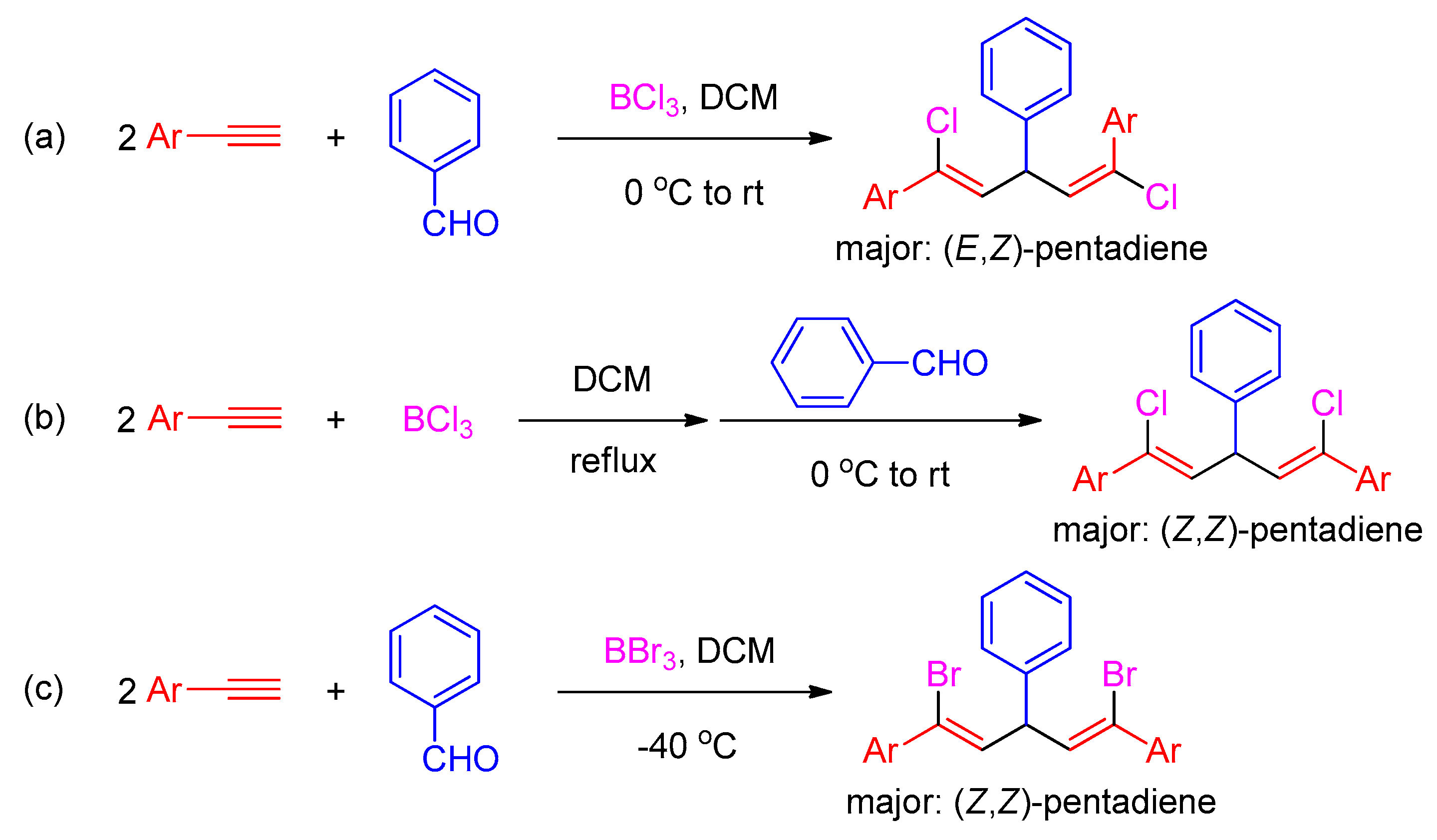
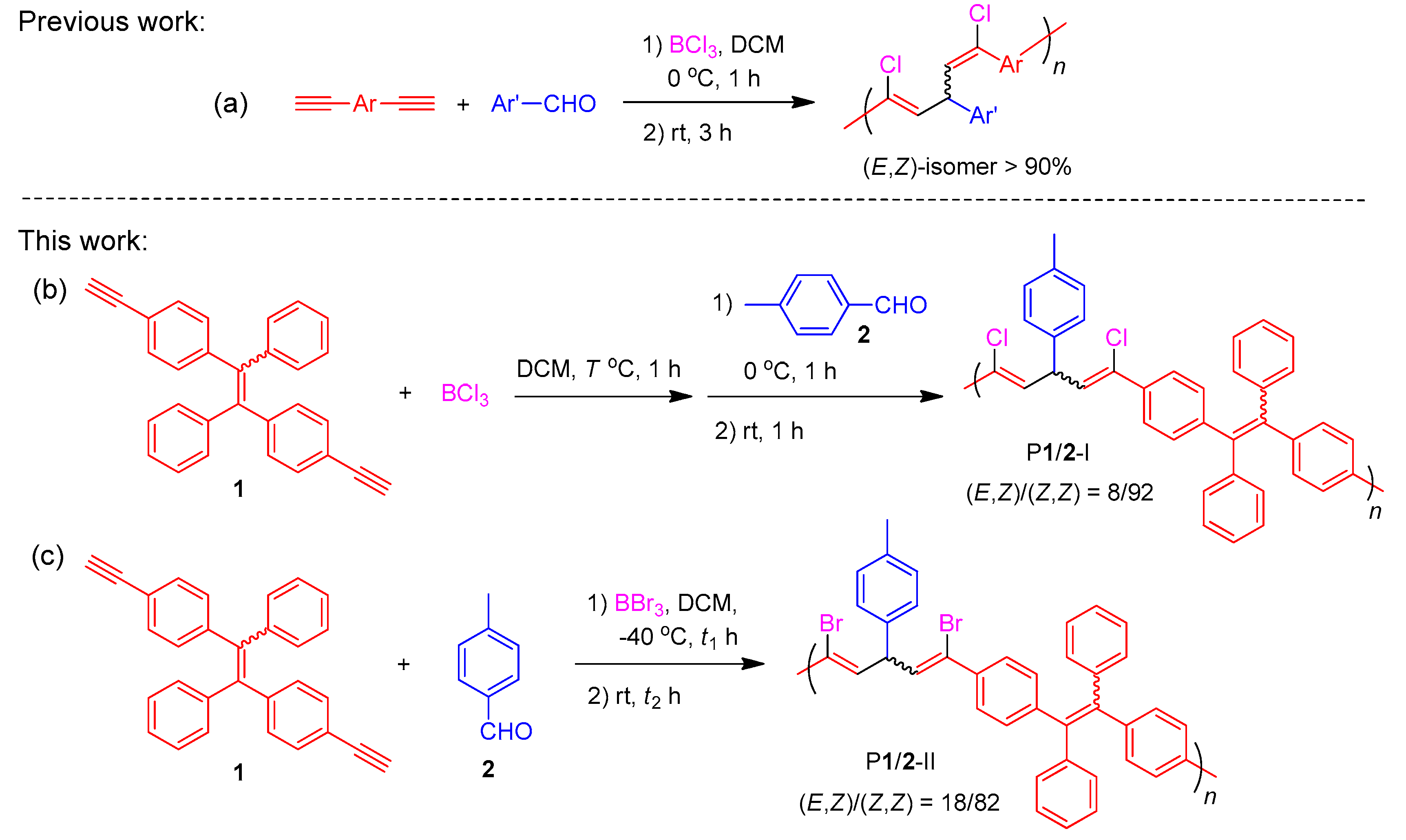

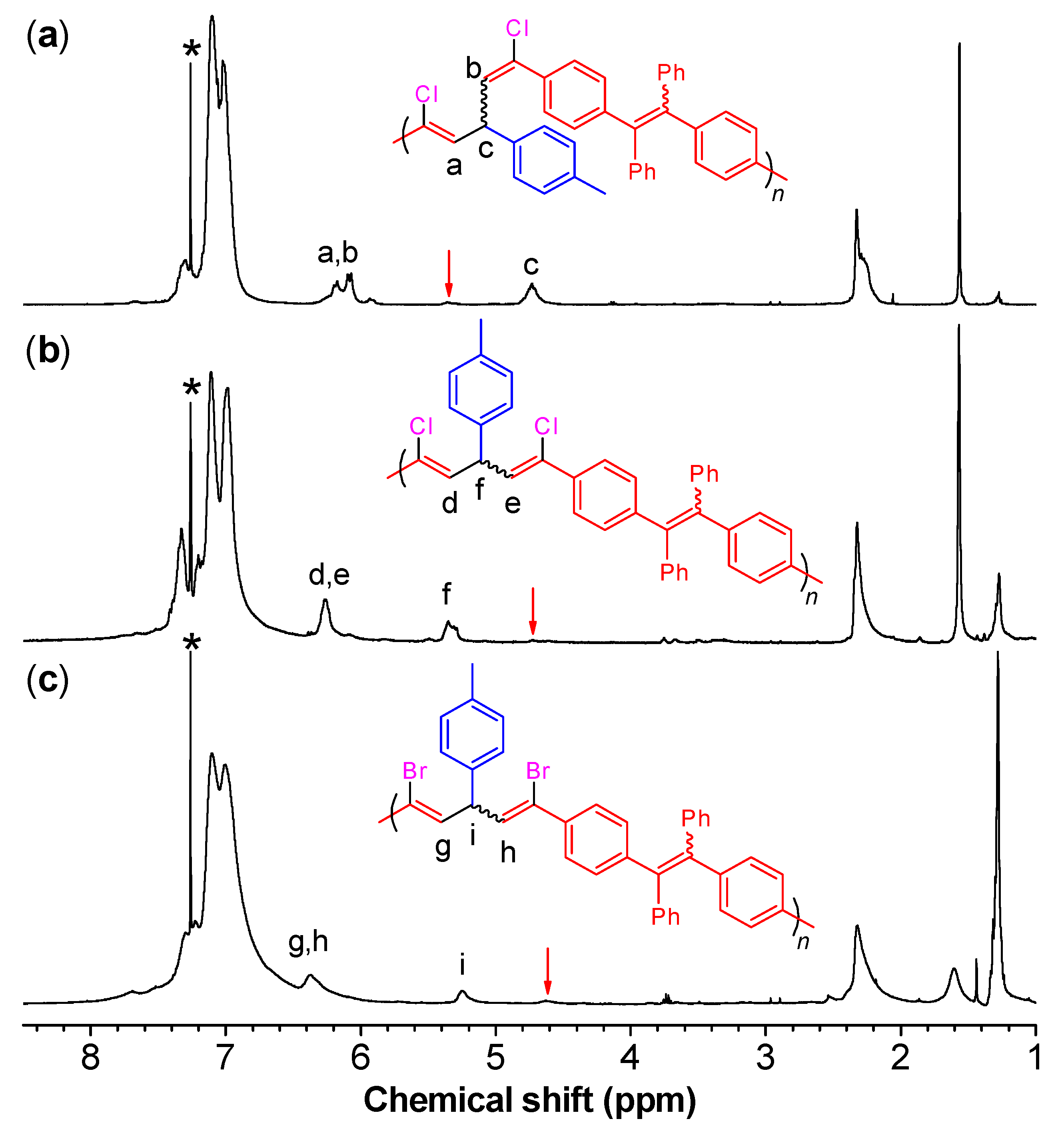
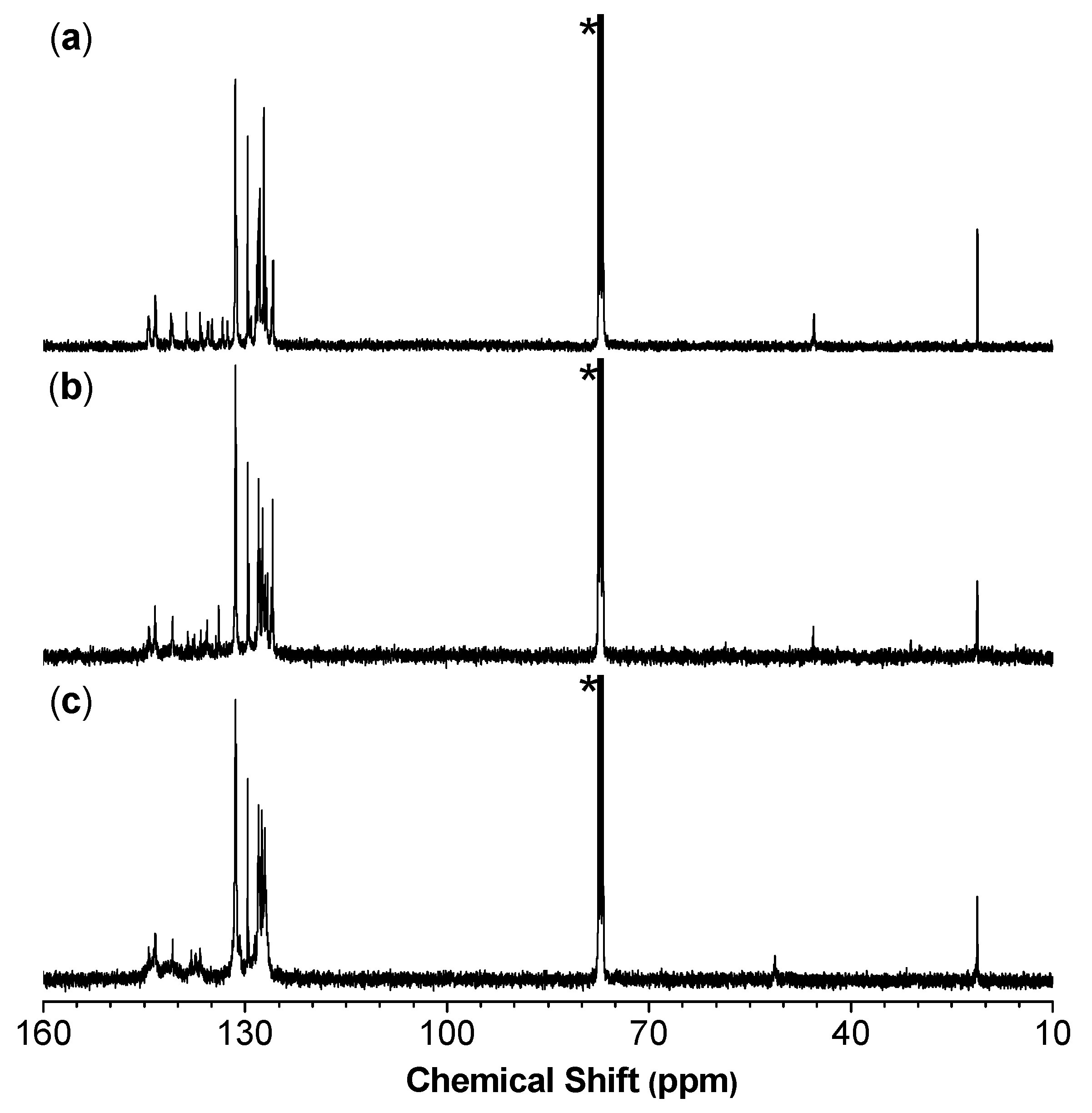
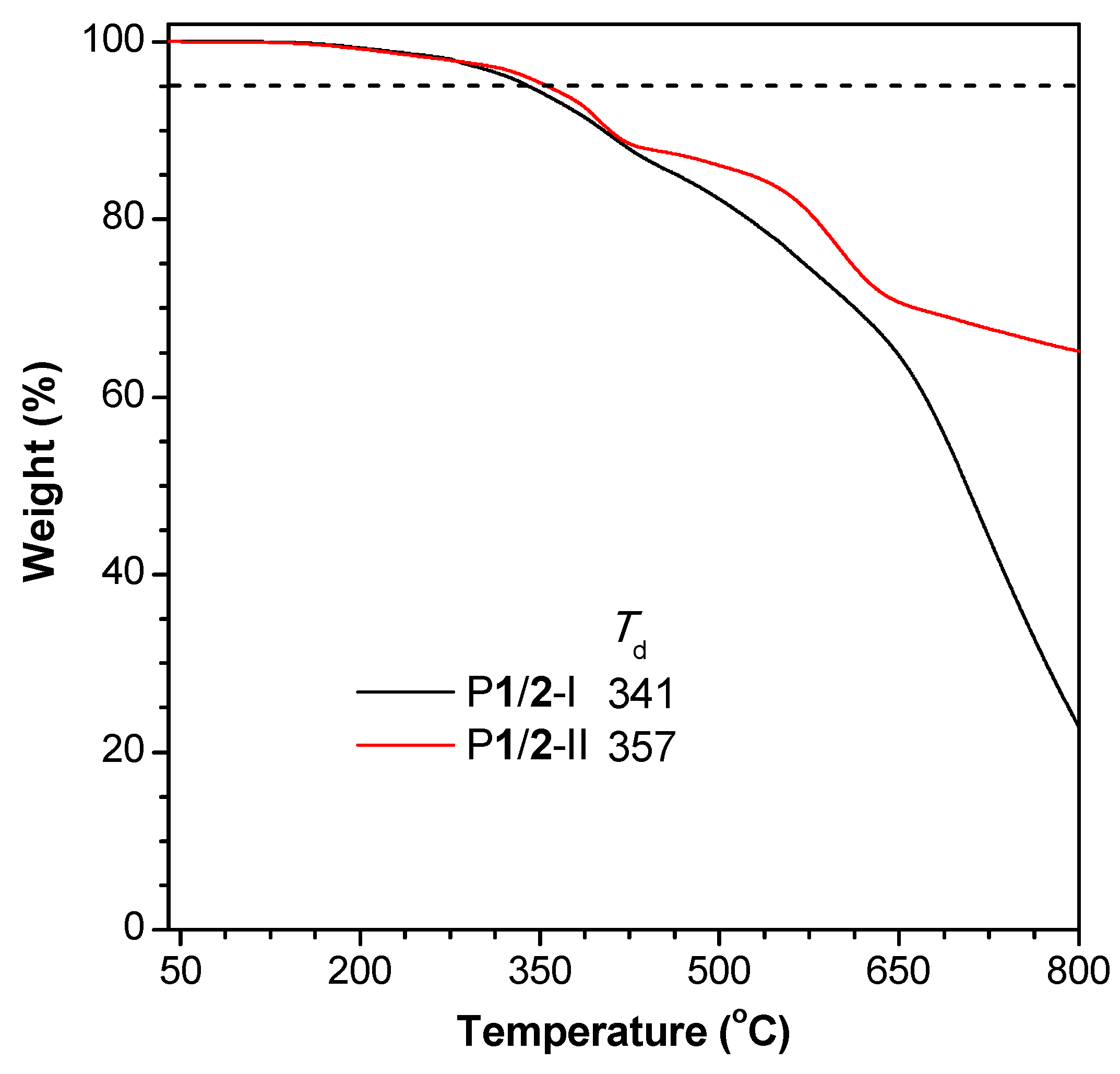
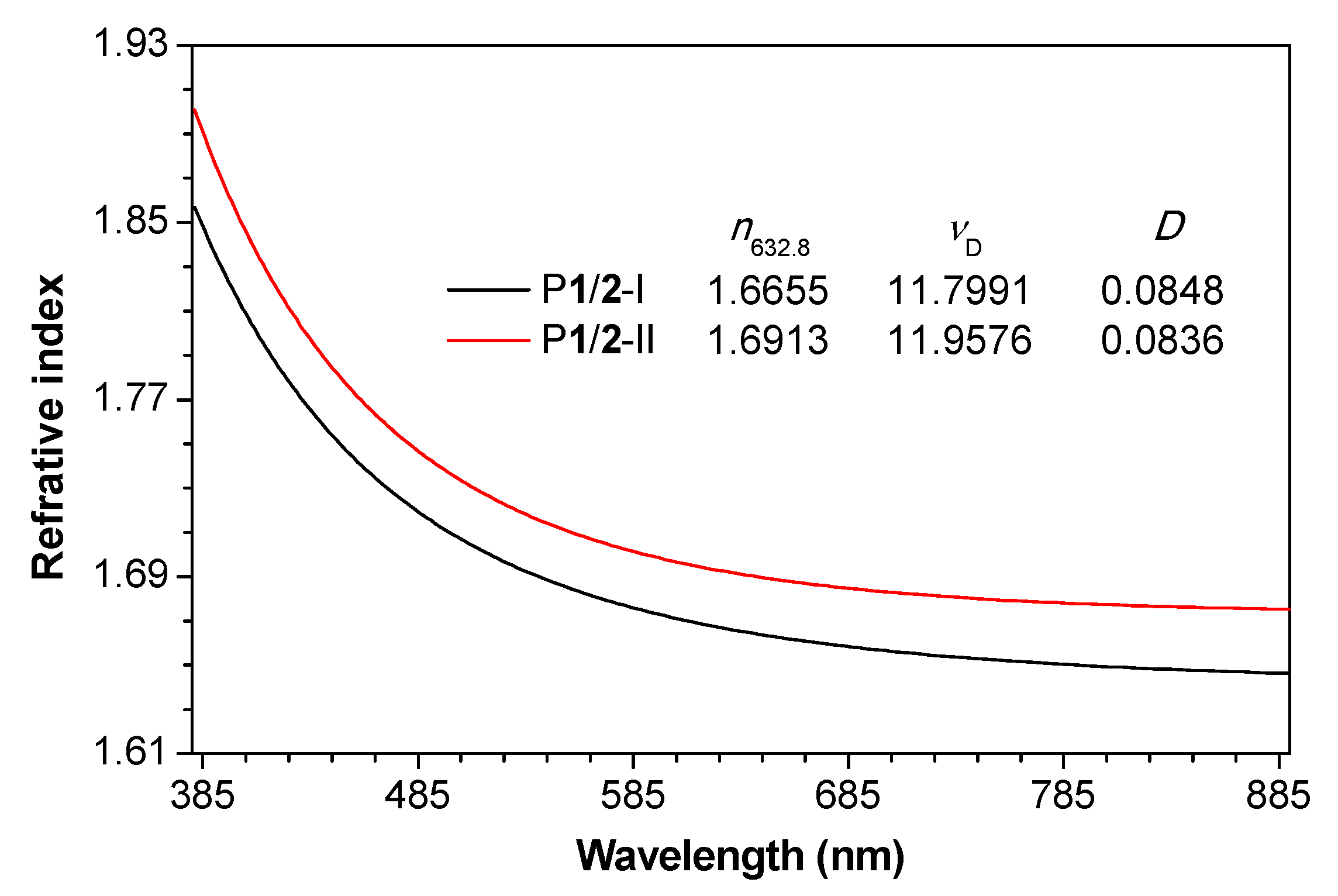

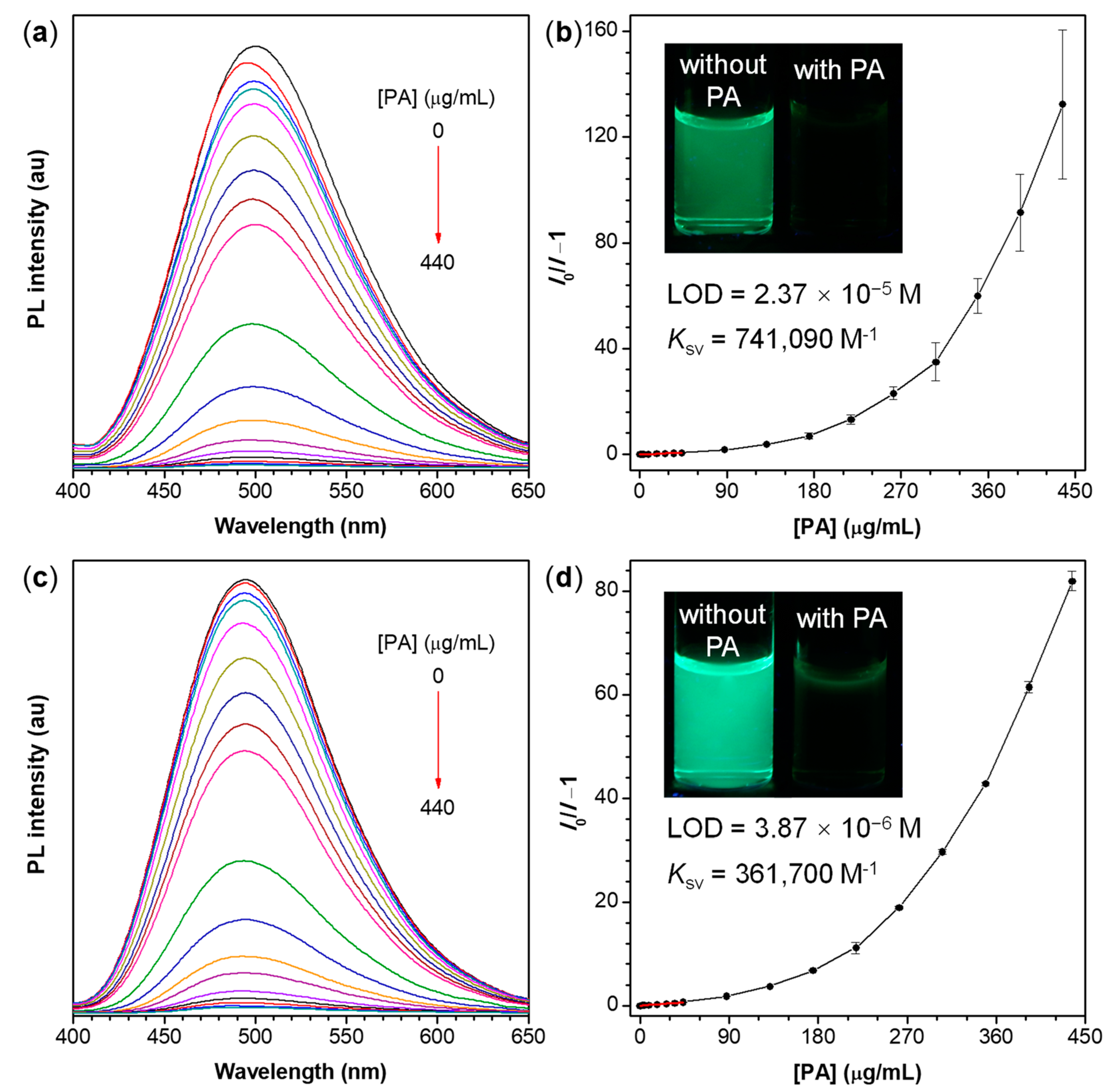
| No. | T (°C) | Yield (%) | Mwb | Mw/Mnb |
|---|---|---|---|---|
| 1 a | 55 | gel | ||
| 2 a | 45 | 68 | 119,700 | 3.9 |
| No. | t1 (h) | t2 (h) | Yield (%) | Mwb | Mw/Mnb |
|---|---|---|---|---|---|
| 1 a | 4 | 0 | 67 | 6900 | 2.3 |
| 2 b | 4 | 1 | gel | ||
| 3 b | 2 | 1 | 79 | 63,100 | 4.3 |
| 4 b | 1 | 1 | 77 | 47,500 | 3.6 |
© 2018 by the authors. Licensee MDPI, Basel, Switzerland. This article is an open access article distributed under the terms and conditions of the Creative Commons Attribution (CC BY) license (http://creativecommons.org/licenses/by/4.0/).
Share and Cite
Han, T.; Zhang, Y.; He, B.; Lam, J.W.Y.; Tang, B.Z. Functional Poly(dihalopentadiene)s: Stereoselective Synthesis, Aggregation-Enhanced Emission and Sensitive Detection of Explosives. Polymers 2018, 10, 821. https://doi.org/10.3390/polym10080821
Han T, Zhang Y, He B, Lam JWY, Tang BZ. Functional Poly(dihalopentadiene)s: Stereoselective Synthesis, Aggregation-Enhanced Emission and Sensitive Detection of Explosives. Polymers. 2018; 10(8):821. https://doi.org/10.3390/polym10080821
Chicago/Turabian StyleHan, Ting, Yun Zhang, Benzhao He, Jacky W. Y. Lam, and Ben Zhong Tang. 2018. "Functional Poly(dihalopentadiene)s: Stereoselective Synthesis, Aggregation-Enhanced Emission and Sensitive Detection of Explosives" Polymers 10, no. 8: 821. https://doi.org/10.3390/polym10080821
APA StyleHan, T., Zhang, Y., He, B., Lam, J. W. Y., & Tang, B. Z. (2018). Functional Poly(dihalopentadiene)s: Stereoselective Synthesis, Aggregation-Enhanced Emission and Sensitive Detection of Explosives. Polymers, 10(8), 821. https://doi.org/10.3390/polym10080821







